Las Máquinas Musicales de Bosch & Simons
“En 1896, Nikola Tesla, uno de los más grandes genios de la era eléctrica, ajustó un pequeño motor oscilante a la viga central de su laboratorio en Manhattan provocando así una poderosa resonancia física que condujo a través del edificio y hasta el suelo, para causar un terremoto que hizo temblar edificios, y rompió cristales y tuberías en un área de doce manzanas. Tuvo que detener el motor a golpe de martillo. Tesla afirmó que podría calcular la frecuencia natural de la tierra y convertirla en una fuerte vibración utilizando un conductor bien ajustado de tamaño adecuado y en un lugar específico.” (*)
Este supuesto aún está vigente en nuestros proyectos vibratorios. Mientras trabajábamos en el tema “Resonancias estimuladas mediante vibraciones mecánicas” nuestro principal interés no sólo era amplificar una frecuencia que ya existía, sino crear un complejo sistema en el que varias frecuencias se influyeran mutuamente. La estabilidad sería entonces tan frágil que incluso la más mínima alteración podría ser capaz de provocar un resultado imprevisible. Al igual que en la Electric Swaying Orchestra (1991-92) las frecuencias naturales y forzadas de los objetos (cajas y muelles, péndulos ) están tan a tono unas con otras que los sonidos y movimientos que produce la instalación pueden alterarse casi imperceptiblemente del orden al caos y viceversa. El papel del ordenador es paradójico: a pesar de controlar el mecanismo (los motores eléctricos), sólo puede predecir vagamente el resultado físico de sus comandos. Y a lo largo de los equilibrios inestables, del orden y del caos, existe el elemento del sonido. La fuerza pura del sonido y el sonido en su más pura manifestación (música) siempre serán parte integral de todas nuestras instalaciones. El sonido, como medio que potencia un lugar especifico, ocupa ese mismo lugar: nuestros proyectos vibratorios nos permiten generar vibraciones con las que podemos llenar el espacio. Después de todo, las ondas sonoras son también vibraciones.
(*)De: ‘The Sound of One Line Scanning’ de Bill Viola en Sound by Artists, Walter Phillips Gallery, Banff, Canada,1990, p.43
TODAS LAS OBRAS

Migratones (2022)
Latex membranes that vibrate according statistical data are combined with field recordings by Sergey Kostyrko.
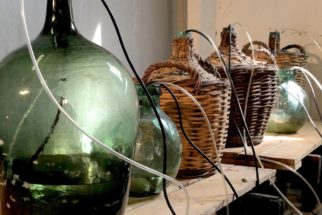
ACUÁTICA (2019-20)
Acuática is a new project in which we capture and mix the sound of air bubbles in carboys filled with water, premiered in CentroCentro, Madrid, October 2019.
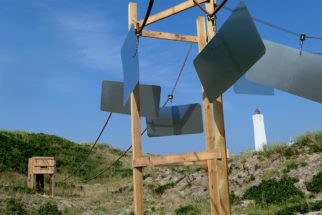
SPRINGTIDE (2019)
A work, powered by the wind that blows six metal plates which hit long metal springs in an extremely unpredictable way.
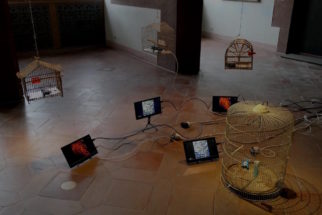
ARRHYTHMIA (2019)
Sounding Industrial vibrators, placed in animal cages, become a relic of what once was a living creature, creating an audio-visual metaphor of a biomechanical machine.
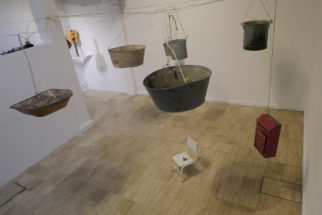
ÚLTIMO INTENTO MINERO (2019)
Último Intento Minero is just the start of a new series in which we transform the properties and history of objects that are characteristic of a city or country into sound and image.
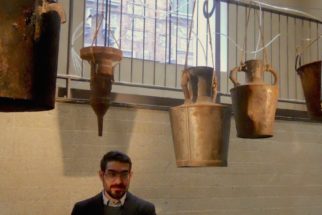
ÚLTIMO ESFUERZO RURAL III (2017)
Once brought into resonance antiquated rural objects recover their forgotten value by producing mysterious, hypnotic sounds.
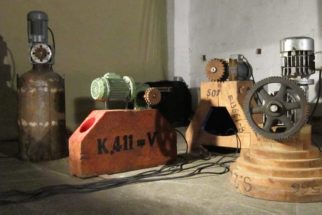
ÚLTIMO ESFUERZO INDUSTRIAL I-IV (2012-2016)
Último Esfuerzo Industrial consists of four electric motors, four frequency controllers, four contact microphones and four bass guitar amps. The piece evokes aesthetics and dreams of the futurist movement of an age ago.
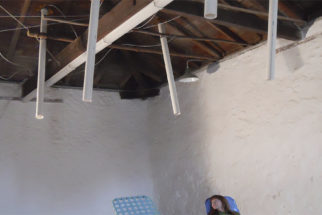
MIRLITONES (2012-2016)
Mirlitones was commissioned by DordtYart, Dordrecht in 2012. A new, improved version was shown at Kidogo, Fremantle during the ICMC / Totally Huge New Music Festival, Perth, 2013.
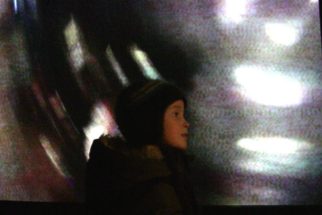
WILBERFORCES (2012-2013)
Wilberforces is a new work within our long series of vibratory projects. The title refers directly to a phenomenon from science, the Wilberforce Pendulum. This pendulum is nothing more than a hung metal spring with below it a central weight plus eccentric weights for calibration.
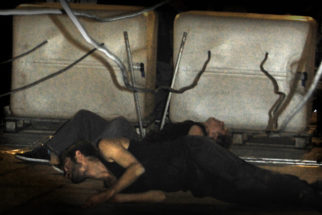
CHUTES LIBRES DE PRINTEMPS (2010/2011)
Chutes Libres de Printemps is a project by Le 8 renversé and Bosch & Simons, a performance by two dancers, double bass and our work Bang Spring Time.
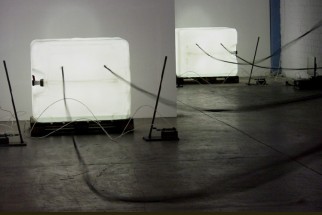
BANG SPRING TIME (2009-2016)
What you see is what you hear: Very long springs between two resonant bodies. Metal bars strike the springs and a wave is set in motion. The sound is born at the same time as the wave, and when the wave dies out the sound also fades away. Or the other way around?
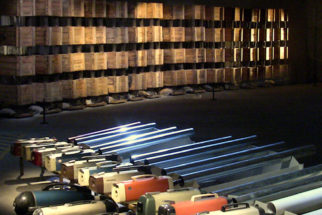
Retrospective
Bosch & Simons (2009)
A retrospective of our work from 1990 until 2008 was held in
Espace Louis Pommier, La Tour du Pin (Isère), France
From September 19 until November 29, 2009.
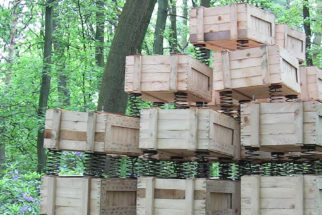
Springtime in a Small Town (2006)
What makes the work different from our other vibratory projects is its environment. The boxes and metal springs abandoned the closed space and inhabit a romantic wood in Belgium. This way the project acquires an almost meditative charge.
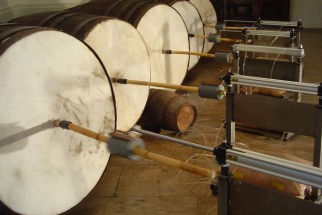
Último Esfuerzo Rural ll (2004-2008)
Último Esfuerzo Rural (“Last Rural Effort”) is composed of two rather different installations. Both produce sounds, big or little, always coarse, sensitive and individual. Part II onsists of giant “zambombas” (lions roars), made of ancient wine barrels, played by pneumatic cylinders.
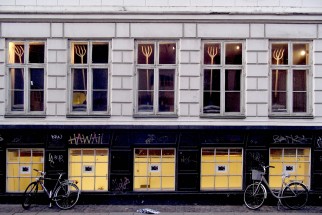
Último Esfuerzo Rural I (2004-2008)
Both parts of Último Esfuerzo Rural produce sounds, big or little, always coarse, sensitive and individual. Part I consists of pitchforks which scratch on glass of windows to be enjoyed inside and outside of the space.
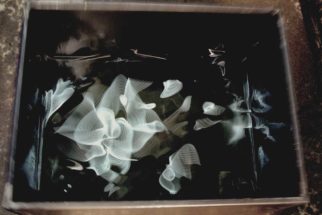
Aguas Vivas (1996/2001-2007)
Oil is sent into vibration and the surface starts to undulate, changing constantly. Light reflected onto the surface of the oil is fragmented. The results are captured with a video camera and projected on a wall, energetic and very hypnotic.
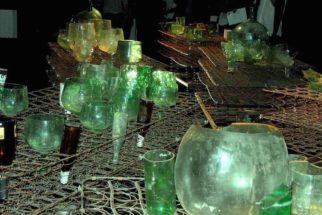
Cantan un Huevo (2000-2001)
Hundreds of metal springs, originally tied together to serve as a mattress, form an extremely complex surface when put into movement. Oscillating motors cause glass bottles, placed on these spring mattresses, to rattle against on another in many ways.
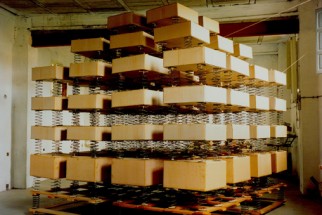
A Castle for Kobe (1996-1999)
A Castle for Kobe was simply a necessity. A small monument in the spirit of Japan. Not something heavy and monumental, meant for eternity, but something fleeting, portable, lightweight.
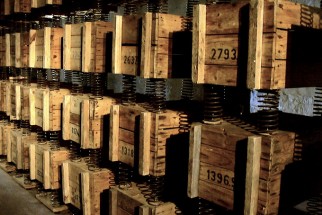
Krachtgever (1994-1998)
The Krachtgever , a 12 meter long wall of wooden crates and metal springs is probably our best-known piece for its Golden Nica, received in 1998 at the Prix Ars Electronica, Linz.
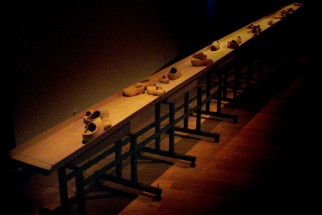
Vooruitgang (1994) and Trajectversterker (1993)
The vibrations generated in the Trajectversterker and Vooruitgang are able to transport objects over a distance on a track constructed of wooden sound chambers.
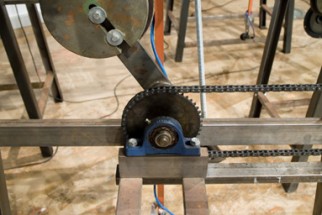
The Electric Swaying Orchestra (1991-1992)
Parametrically-driven pendulums is a well-known subject within the cadre of order and chaos theories. Unpredictable, labile equilibriums lead to situations that are impossible to control entirely.
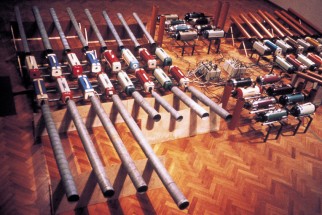
Was der Wind zum Klingen bringt (1989-1990 / 2003)
An apparently unpredictable sequence of timbres, harmonies and dynamics are combined to create the illusion of a living object.

























